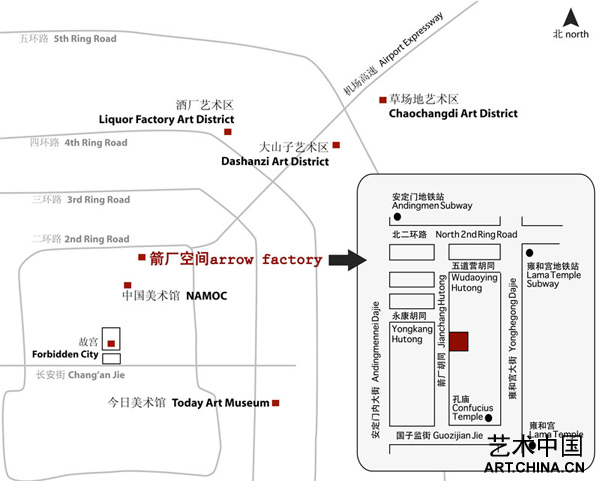|

《維瓦拉蒂法蘭西》——倪海峰
展覽地點:箭廠空間
Ni Haifeng @ Arrow Factory
2008.11.07 - 2009.01.07
www.arrowfactory.org.cn
www.arrowfactory.org
www.jianchang.org
《維瓦拉蒂法蘭西》(差異萬歲Vive la Difference)是藝術家倪海峰創作的一件裝置作品,在箭廠空間櫥窗式設計的背景之下呈現了製造、消費以及商品化的問題。利用商業化的生産中廢棄的工業垃圾(織物碎片),藝術家同兩個截然不同的勞動者通力合作,製作出兩件獨特的"高端"時裝外套,將以高級櫥窗展示的形式在箭廠空間展示。兩件外套都有著同樣的出發點——一件由法國高檔品牌"愛馬仕"(Hermès)設計的服裝——和同樣的材質(一箱碎布),但是社會背景和製作過程卻迥然有別。倪海峰選擇了與兩個具有完全不同背景的團隊合作——一個是坐落在箭廠空間附近衚同裏的一家叫做"別具一格"的夫妻裁縫店,以為鄰里居民提供縫紉製衣,縫補和洗滌服務為生;另一個則是目前在北京的法國及澳洲設計師Aurelien Lecour和Tony Saint Hua,迪梵谷級時裝工作室的創辦人,他們工作在時裝工業的創造性領域。兩個團隊當中的每一個都被要求根據一張"原創"設計的圖片來重新闡釋和複製各自的服裝,其結果不僅是形成了兩種不同的審美反應,而且揭示了這兩種完全不同但卻並行的勞動模式之間的社會差異。通過有意選擇經濟背景有著巨大差異的合作者,將製作的創造性行為交與他人,倪海峰著眼于一種生産的社會過程,生産的手段受到質疑,而清晰的原創者身份的概念則被瓦解了。《維瓦拉蒂法蘭西》在這一平凡粗陋的衚同環境中,尋求揭示極端奢華與凡俗的日常生活之間的視覺上的不和諧,以及隱藏在生産與展示背後的社會摩擦。'維瓦拉蒂法蘭西'或者'差異萬歲'不無嘲諷地重申,在'低端'與'高端'之間,在無人問津之物與極端的慾望之間,在嚴峻的社會現實與消費主義的烏托邦承諾之間所存在的不可調和的差異。
倪海峰(1964年出生於舟山)的藝術實踐源自對回歸、交換、語言和生産等文化體系的關注。他在中國出生和成長期來,但目前定居荷蘭,運用攝影、錄影和裝置來探索意義的同時發生和消解,提醒人們關注常常折射出殖民主義和全球化模態的人物、産品以及商品的迴圈運動。他的目的在於打破現狀,對抗先入為主的藝術概念,用藝術家自己的話來説,就是要努力達到 "零度意義"。倪海峰的作品在國內和國際上多次舉辦個展和群展。目前生活在阿姆斯特丹和北京兩地。
藝術家與箭廠空間感謝Le Divan品牌服裝店和"別具一格"的盧先生在合作過程中慷慨相助。"箭廠空間"是一個由獨立策展人和藝術家組織策劃的藝術櫥窗項目。空間位於北京市中心的衚同裏,原本是個小商鋪,經過改造後擁有10平方米的展出面積。"箭廠空間"首先希望通過櫥窗這種特殊的展示方式,為藝術家的創作方法提供一種新的可能,空間內定期更新的藝術作品將會在這裡每天面對不同的社會群體和文化情境。其次項目自身也試圖探討藝術與日常生活之間的美學關係,嘗試藝術創作與公共空間的有機對話,促進當代藝術的試驗,交流與研究。"箭廠空間"將會積極地邀請國內和國外的藝術家提供現場裝置和項目。

Vive la Difference: Ni Haifeng @ Arrow Factory
Vive la Difference is an installation created by artist Ni Haifeng that presents issues of production, consumption and commodification within the context of a shop window design at the Arrow Factory. Using shreds of fabric that have been discarded after commercial factory production, the artist has collaborated with two different design teams to produce a pair of unique "high-end" fashion garments that will be presented in Arrow Factory's space in the form of a luxury store window display. The two garments share the same origin—a dress designed by French luxury brand Hermès—and the same materials (a box of fabric shreds) but the social context and process of production is entirely different. Ni has chosen to work with two workers with incongruent backgrounds—one is a Chinese run 'mom and pop' tailor shop Bieju Yige (別具一格)located in the hutong adjacent to Arrow Factory that subsists on tailoring, mending and patching clothes for the neighborhood residents, and the other is Beijing based French-Australian designers Aurelien Lecour and Tony Saint Hua, creators of Le Divan Studio who work in the creative sector of fashion industry. Each has been enlisted to reinterpret and reproduce their own dress based on an image of the unique "original" design, with the outcome intended not only to yield two different aesthetic responses, but to also acknowledge the social discrepancy between these two diverse yet parallel forms of labor. By purposefully choosing collaborators with dramatically different economic backgrounds and handing the creative act of making over to others, Ni engages with a social process of making where the means of production are questioned and clear notions of authorship are disrupted. Vive la Difference seeks to expose both the visual dissonance between the extremely lavish and the mundane everyday and the hidden social frictions of production and presentation within the humble surroundings of the hutong. Vive la Difference or 'Long Live the Difference' mockingly reiterates the irrevocable differences between the 'low' and the 'high', between the unwanted and the 'highly desirable', between grim reality and utopian promises of a pan-consumerist society.
Ni Haifeng's (b.1964, Zhoushan) practice stems from an interest in cultural systems of return, exchange, language and production. Born and raised in China but currently a resident of The Netherlands, Ni employs photography, video and installations to explore the simultaneous creation and obliteration of meaning while drawing attention to the cyclical movements of people, products and goods that are often reflective of patterns of colonialism and globalization. His aims to subvert the status quo and counteract preconceived notions of art are, in his own words, an effort towards reaching a 'zero degree of meaning'. Ni's work has been exhibited in numerous solo and group exhibitions locally and internationally. He lives between Amsterdam and Beijing. The artist and Arrow Factory would like to thank the generous assistance of Le Divan Studio and Bieju Yige for their collaboration.
Arrow Factory is an independently run alternative storefront space that seeks to advance artistic collaboration, exploration and experimentation across different cultural contexts and viewing publics. Located in a small hutong in Beijing's city center, Arrow Factory reclaims existing commercial space to present artworks that stimulate dialogue between art and contemporary urban space. Aimed at reaching a diverse public made up of local residents, as well as local and international art audiences, our modestly sized space (approx 10 square meters or 100 square feet) is intended to create new avenues for artistic production in China and further aesthetic relationships between contemporary art and everyday life. Arrow Factory will invite artists living inside and outside of China to create site-specific installations and projects that will be available for view in its storefront location 7 days a week.
箭廠空間
箭廠衚同38號 (國子監街內)
北京 100007 中國
Arrow Factory
38 Jianchang Hutong (off Guozijian Jie)
Beijing, 100007 China
|

